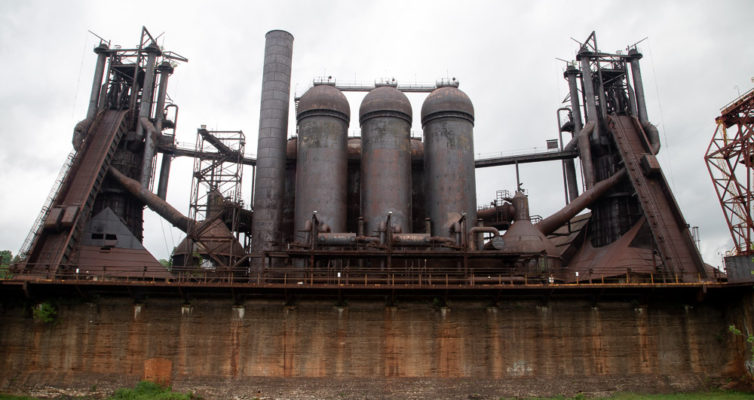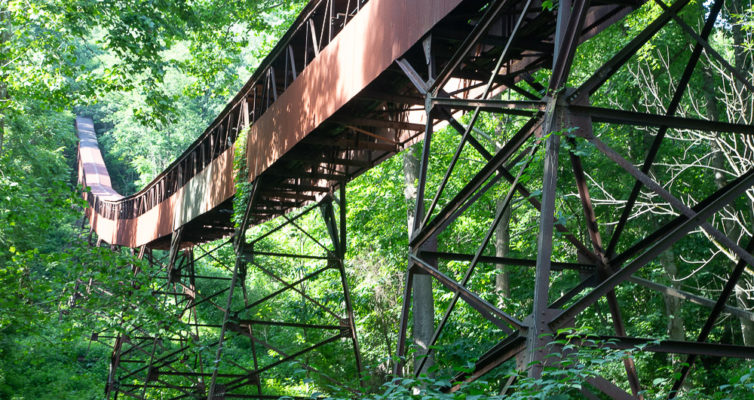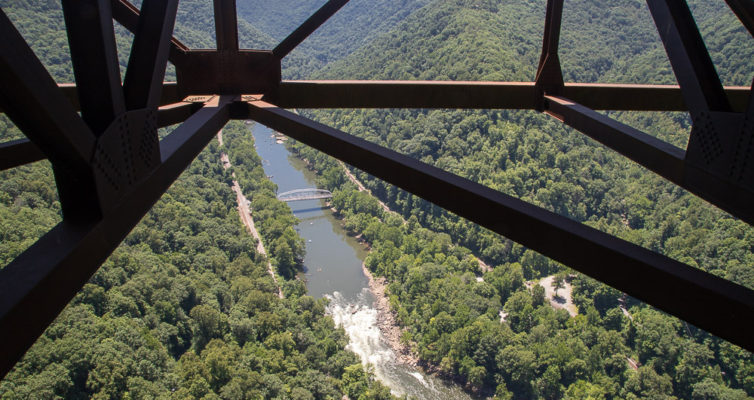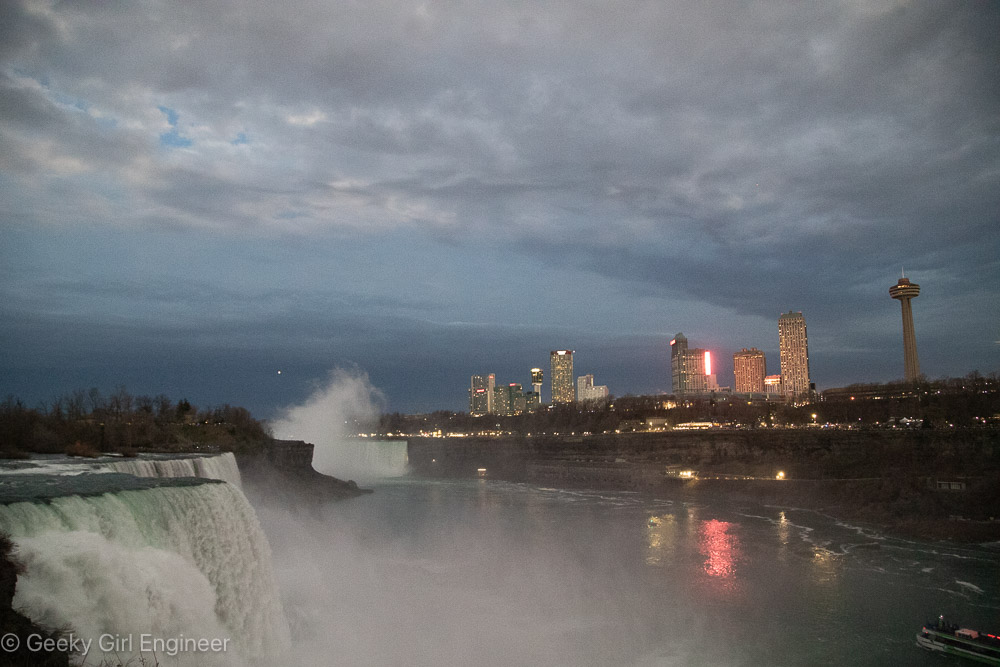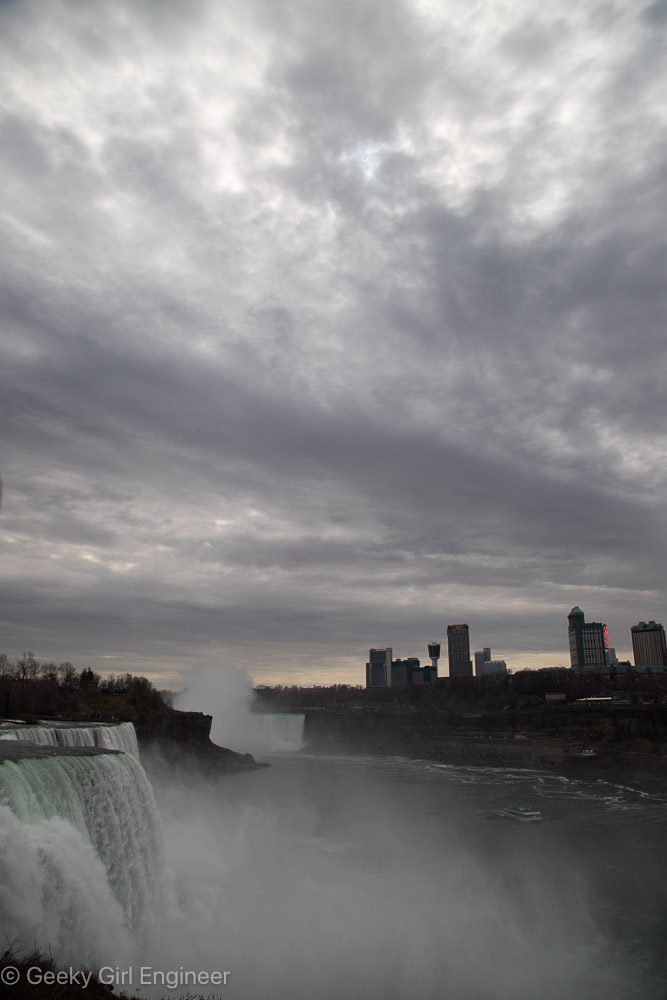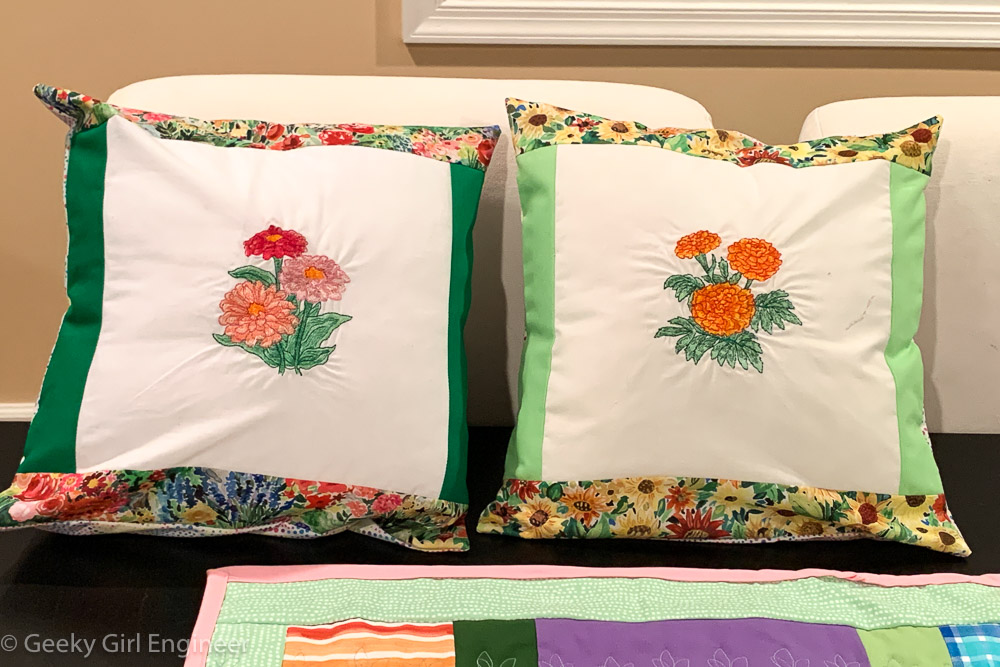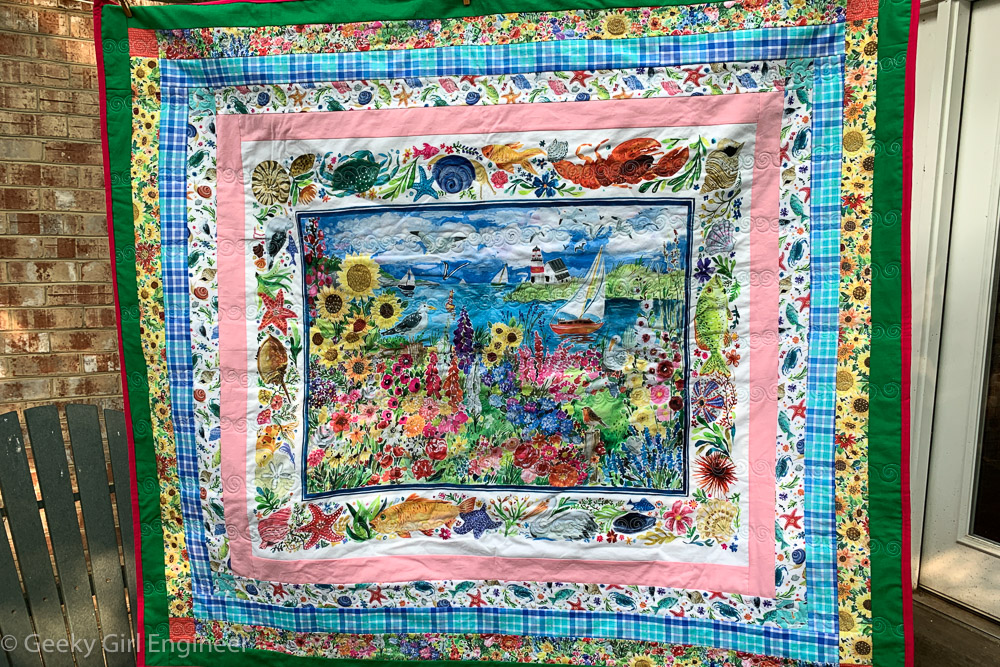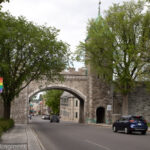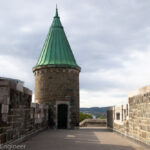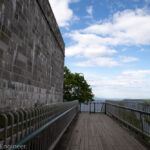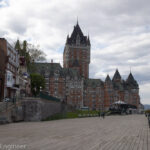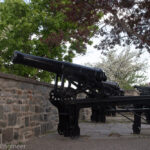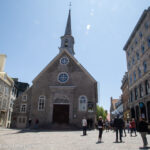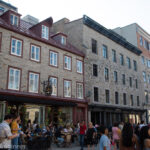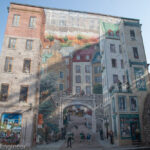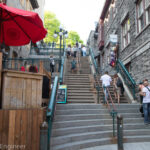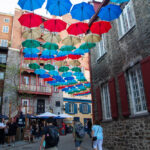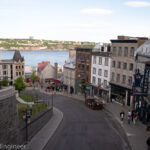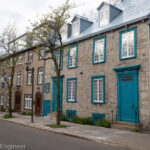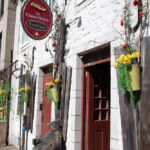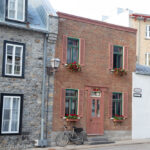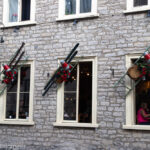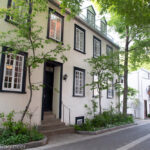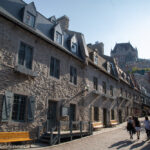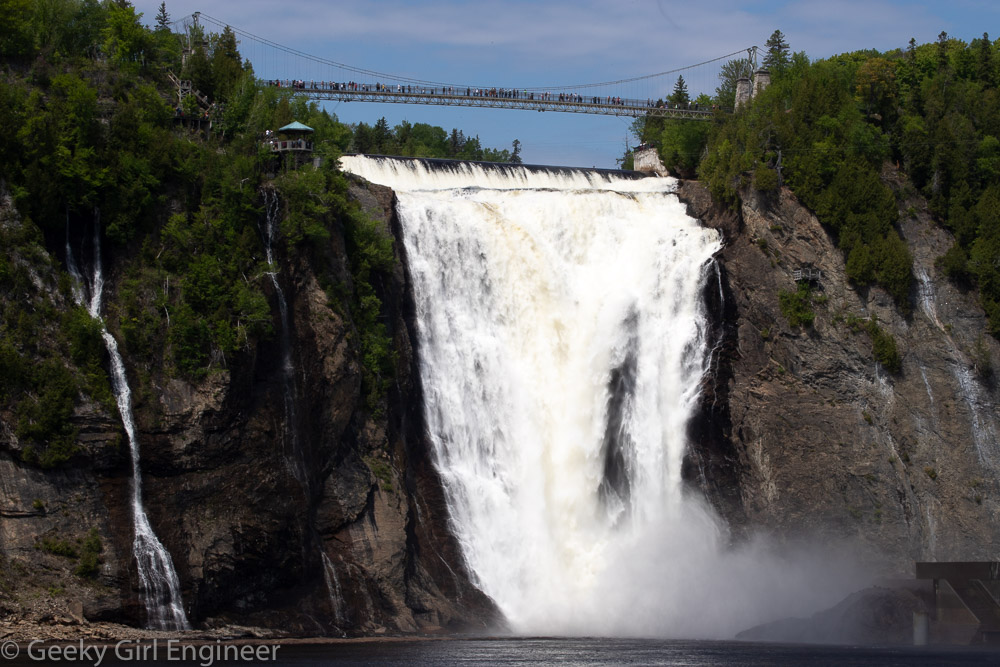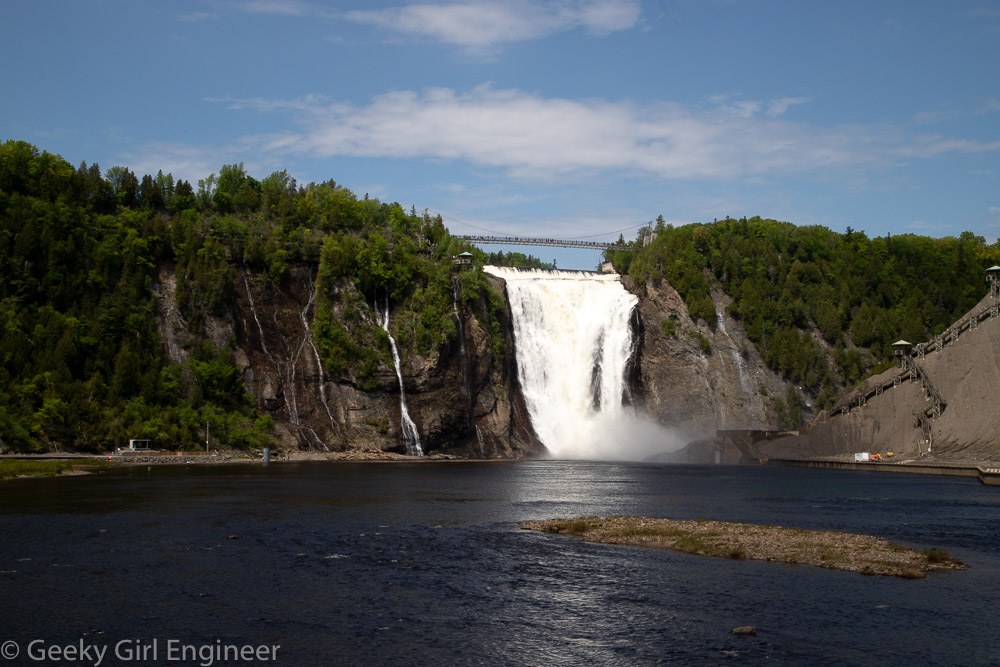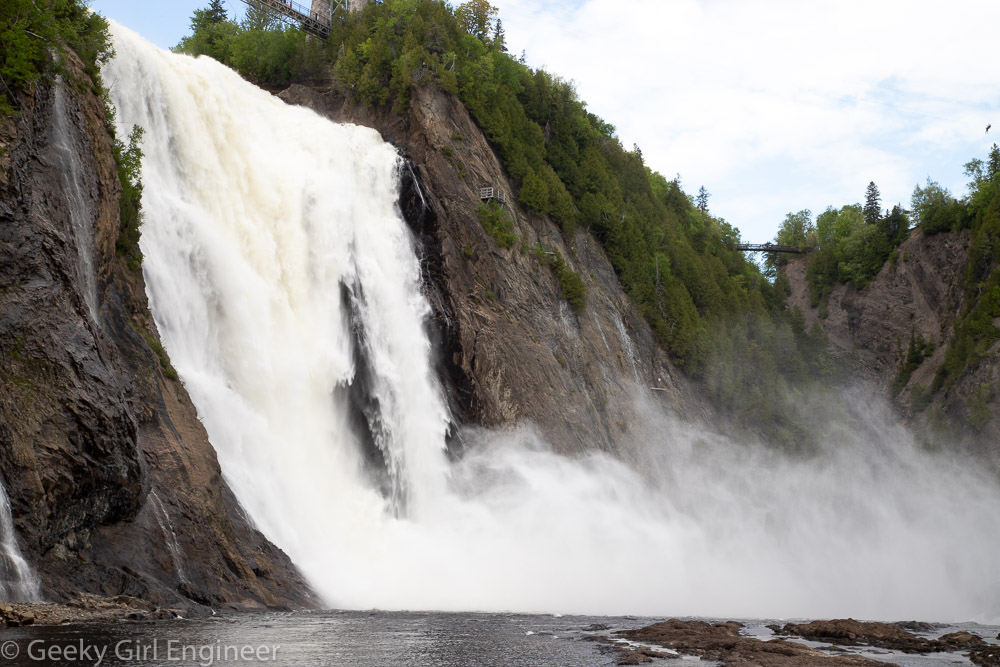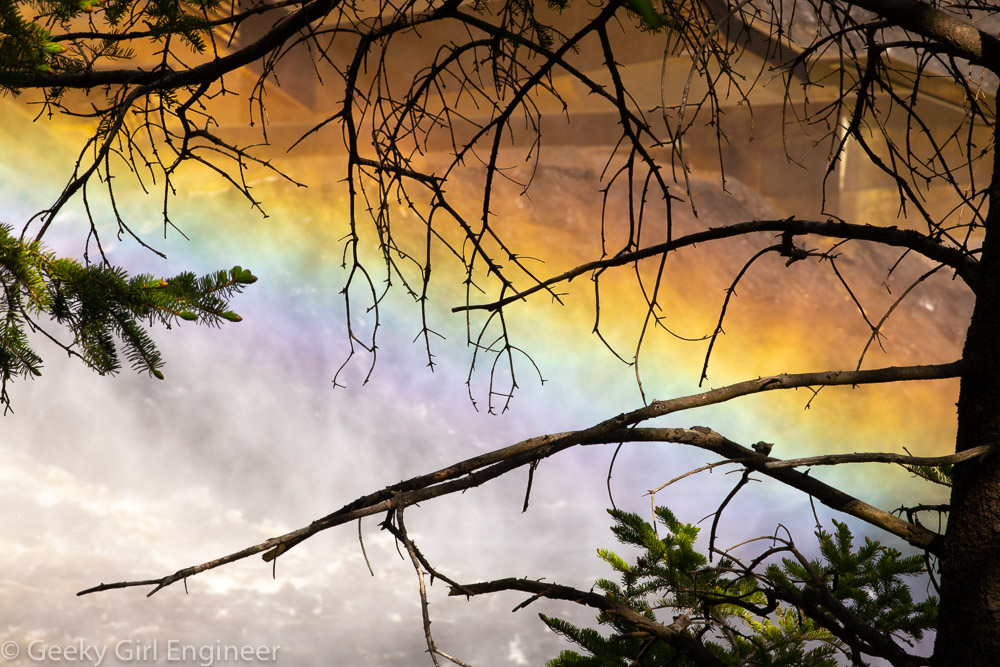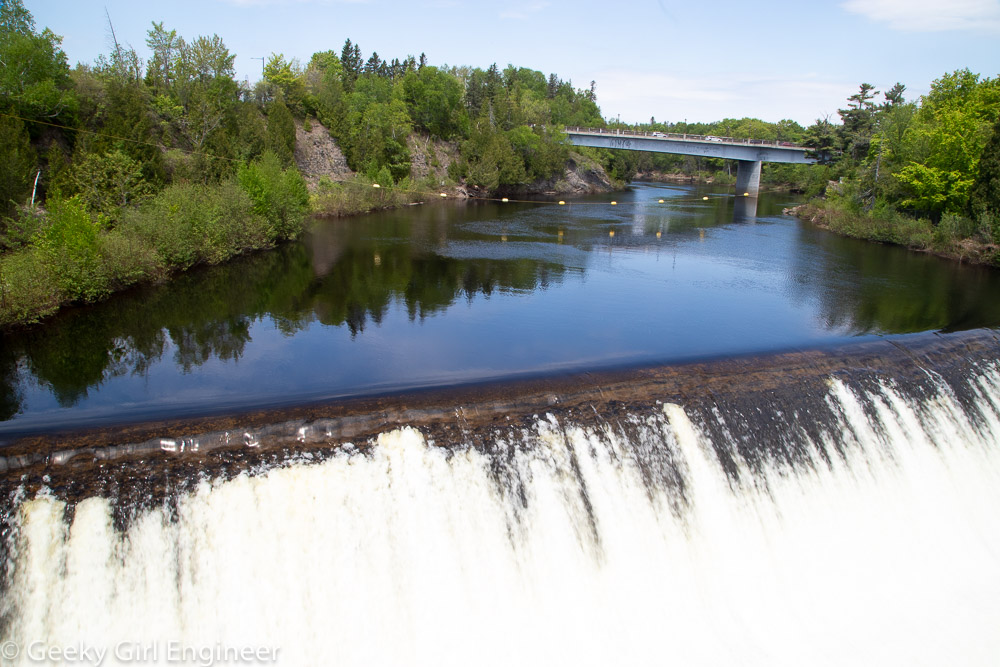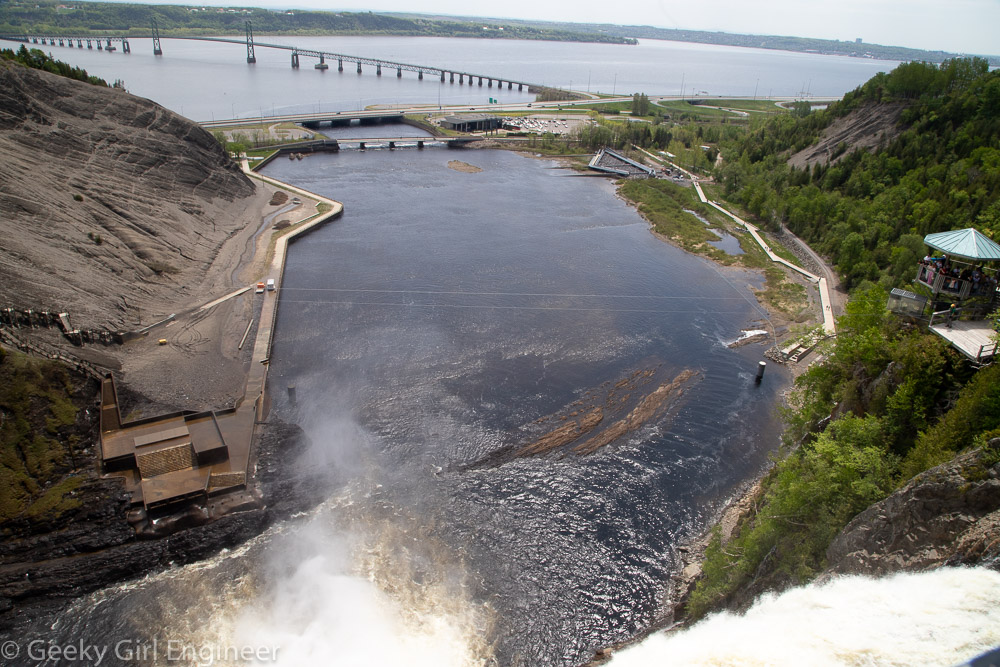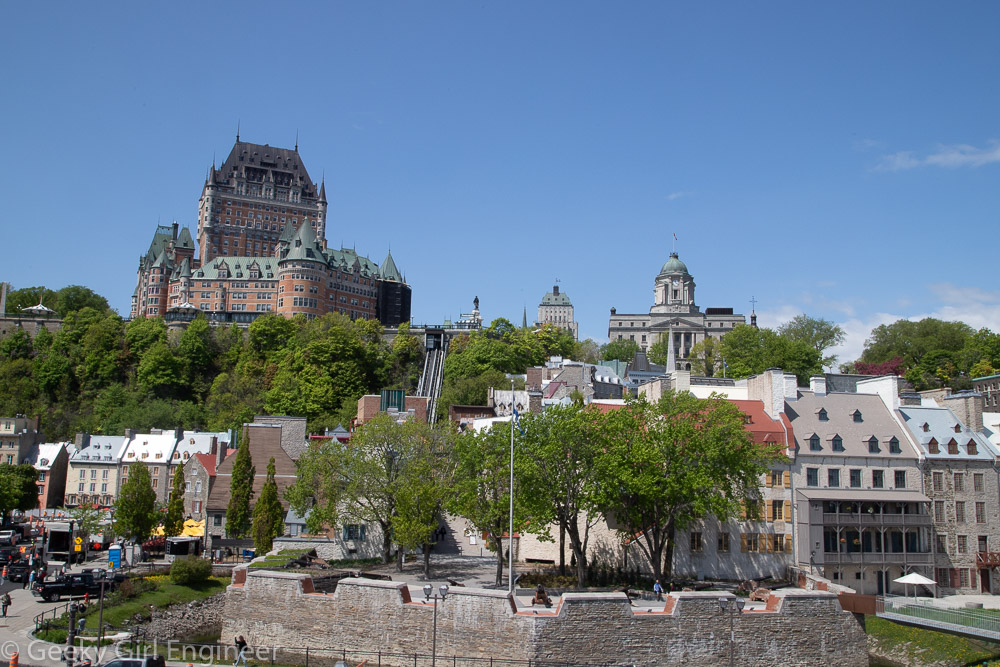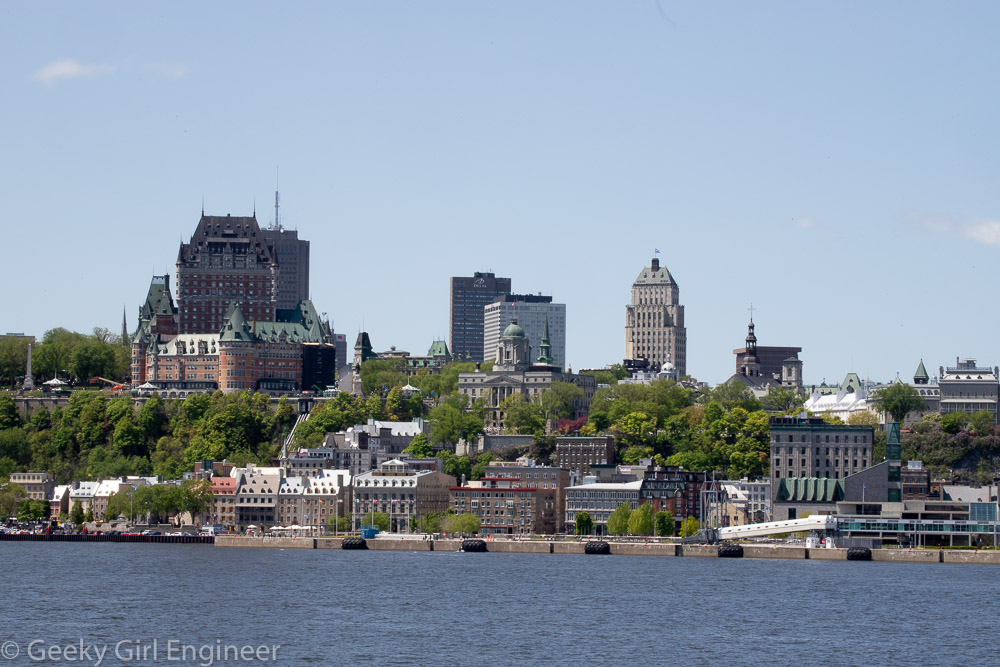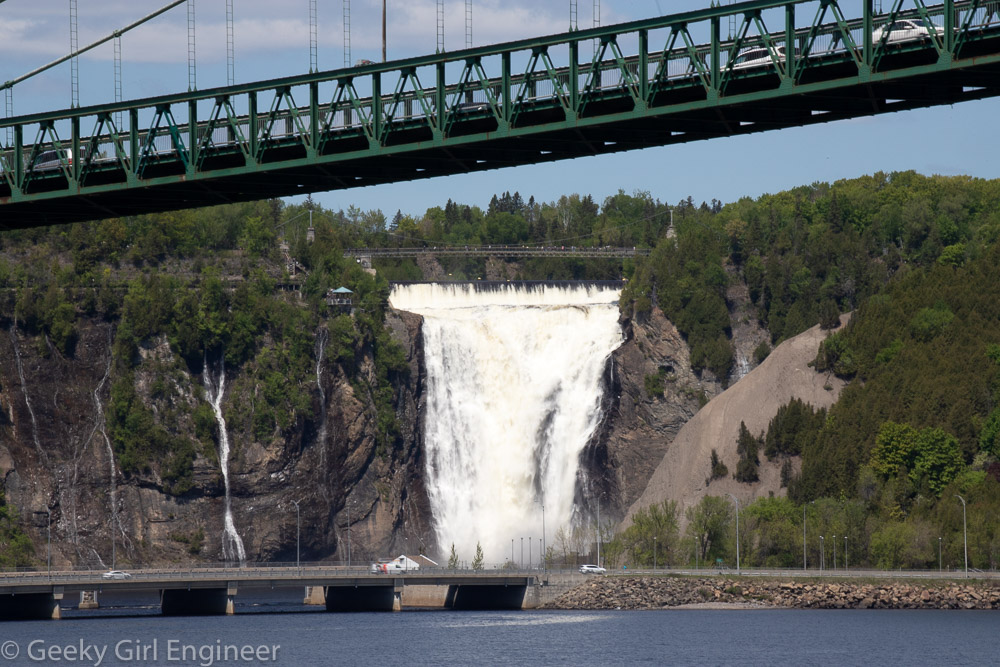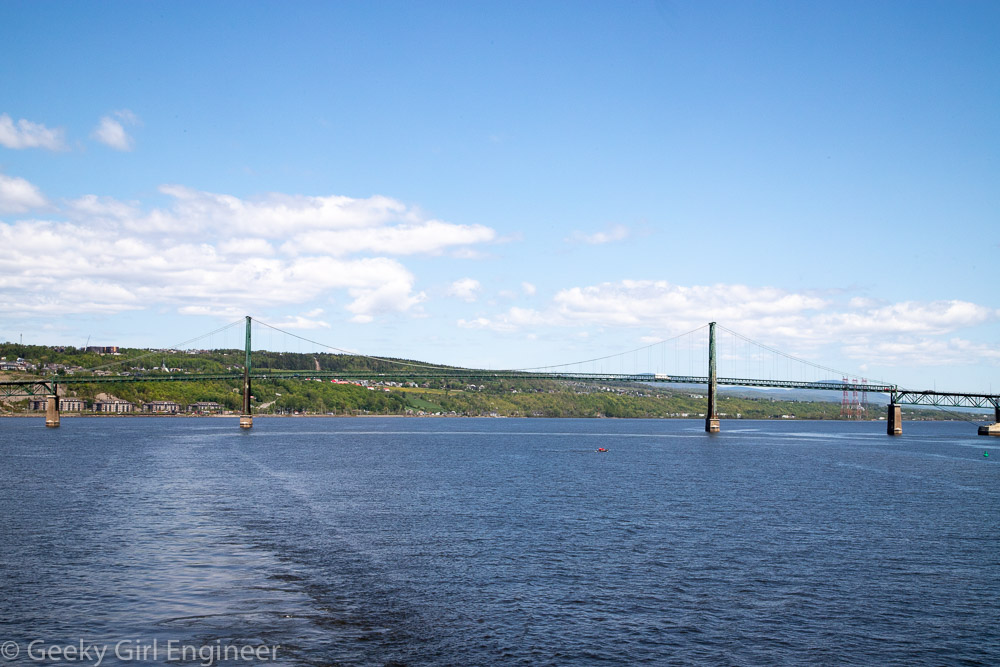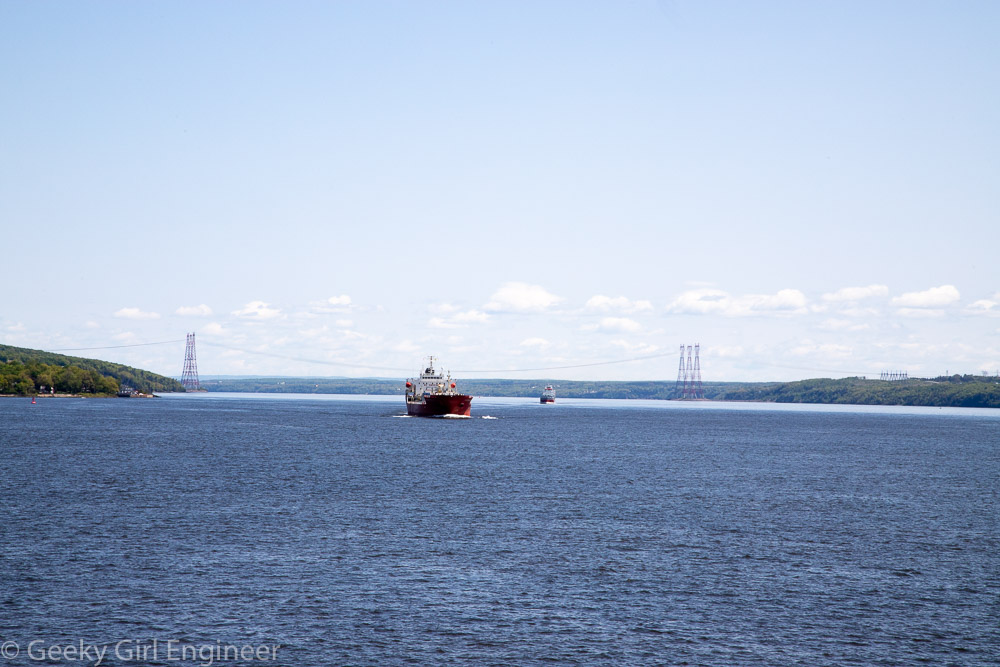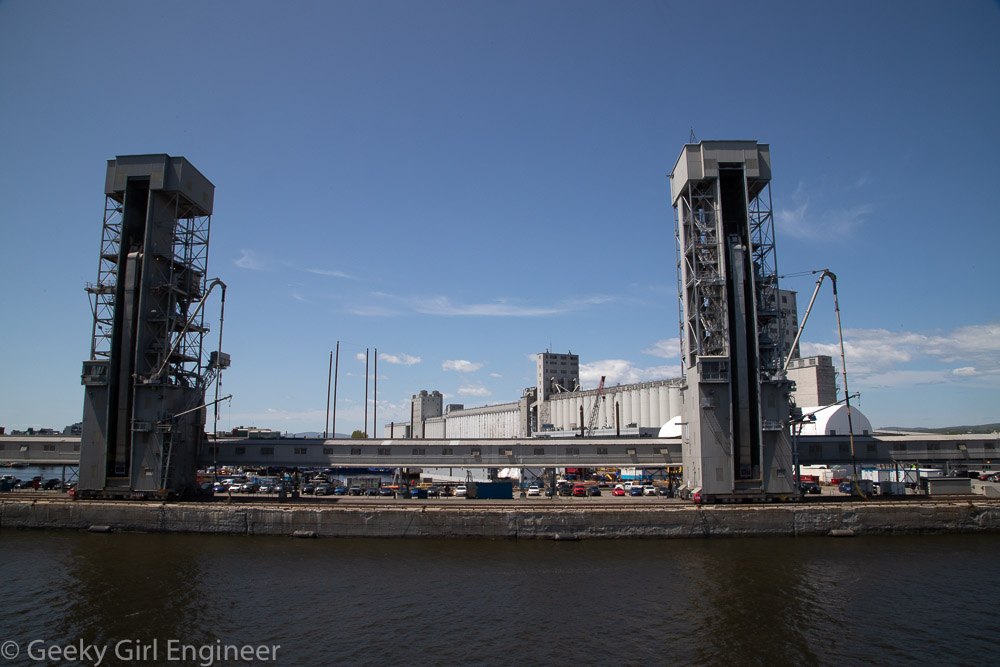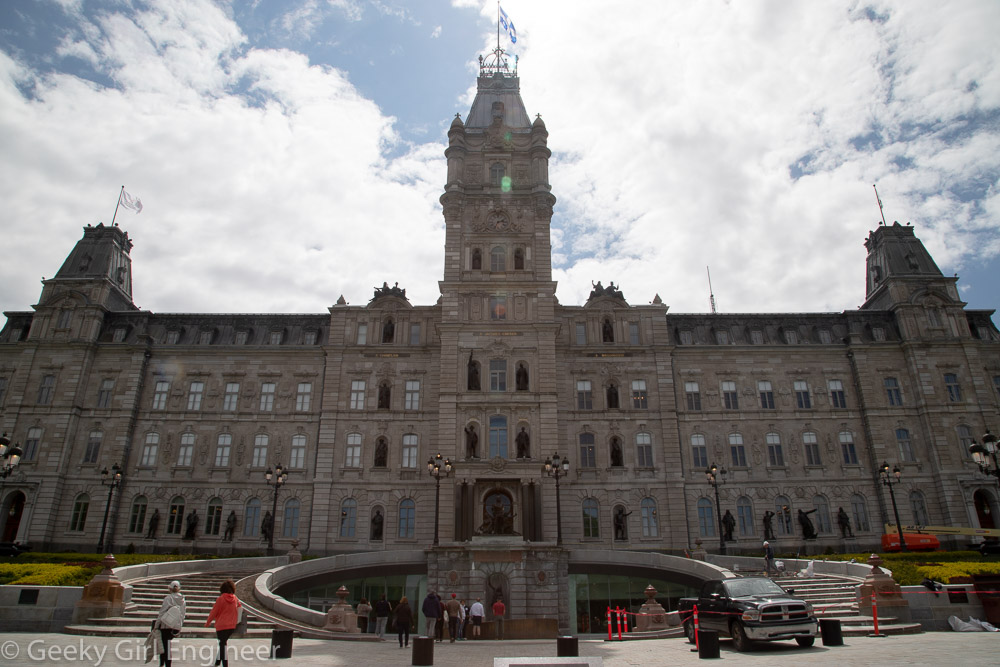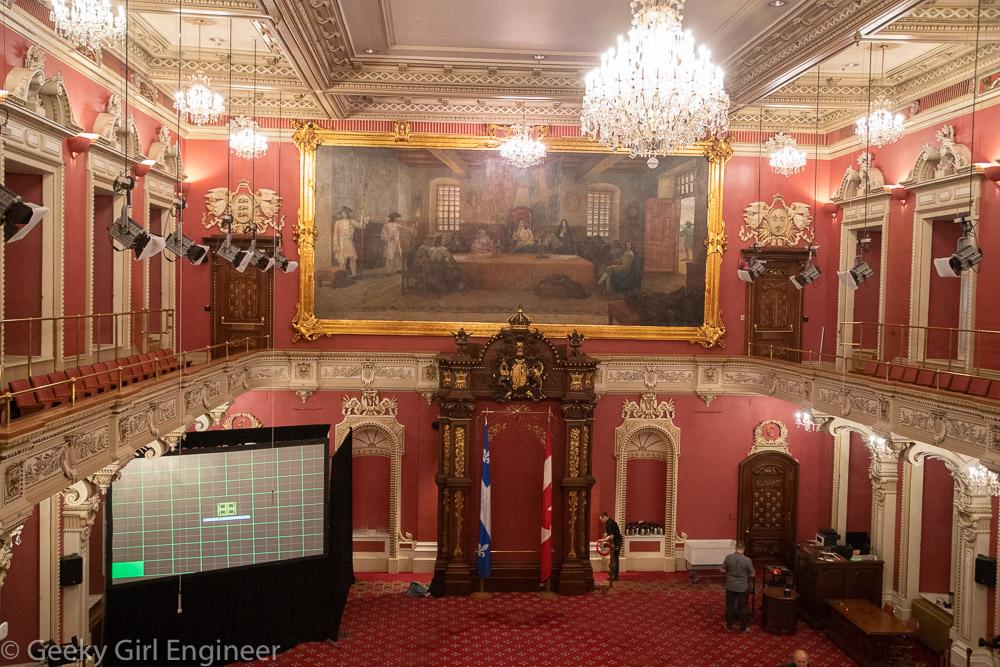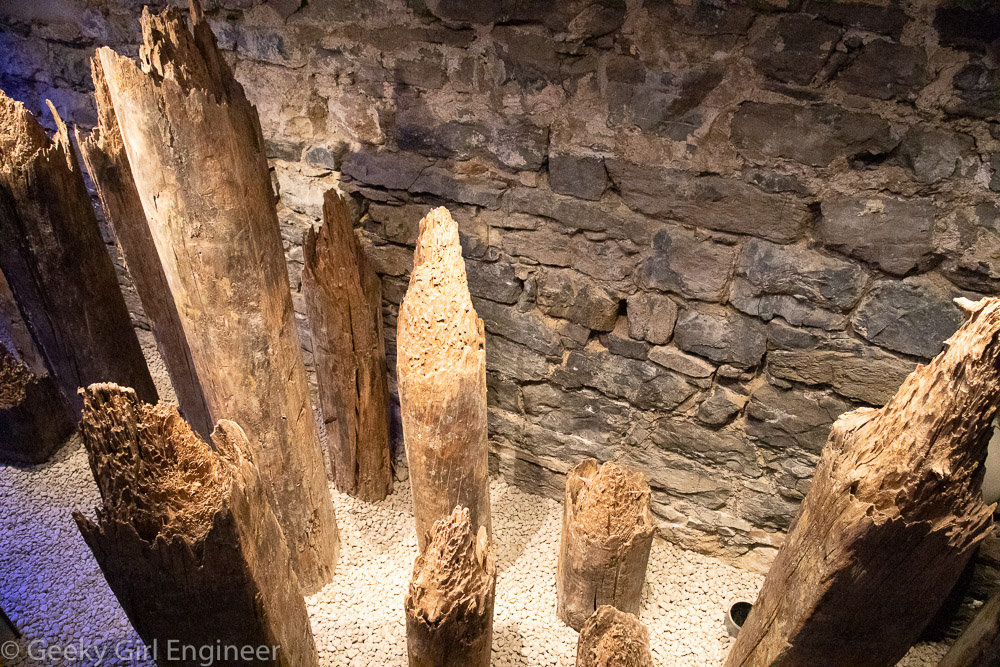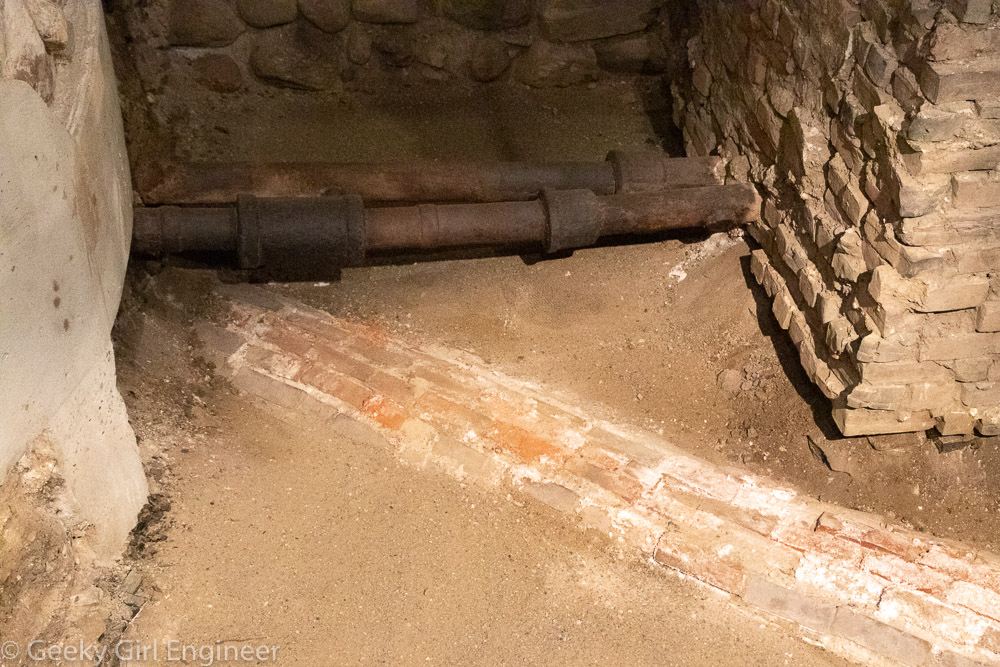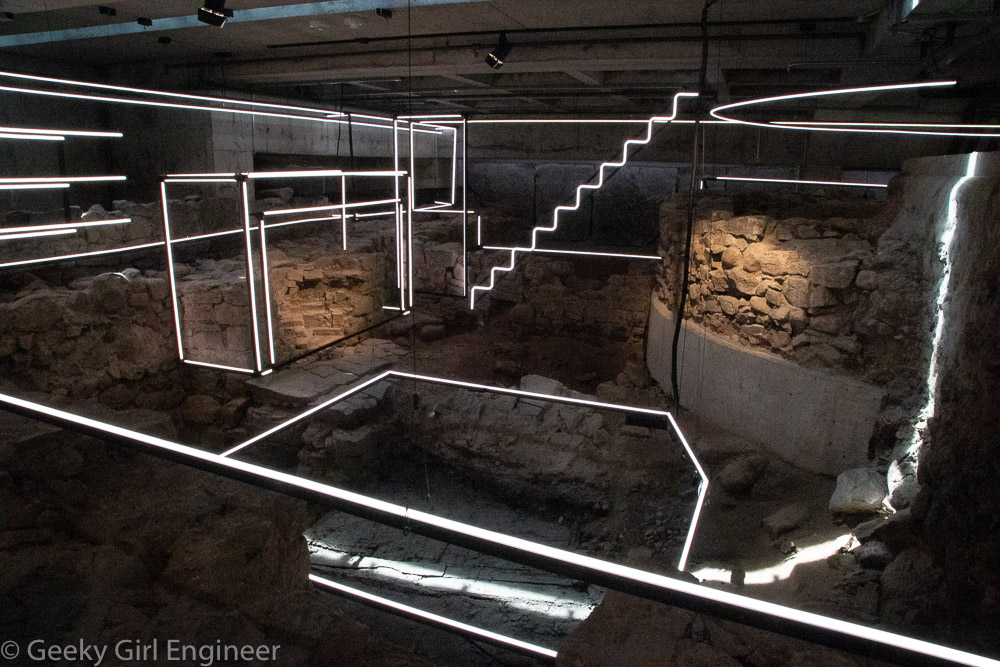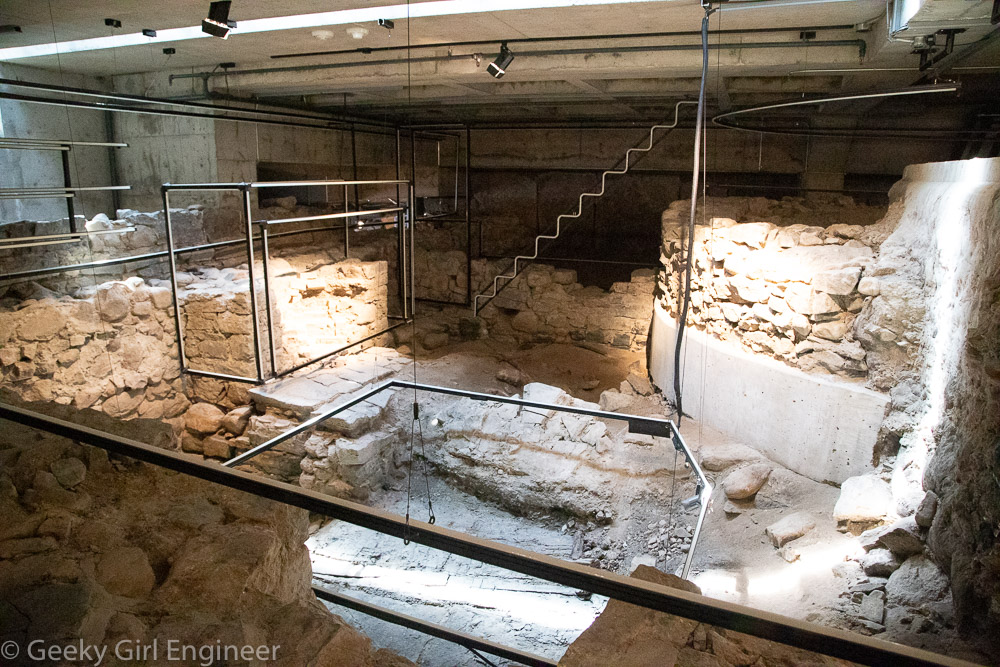I came to Niagara Falls for the 2024 total solar eclipse with the idea of spectacular images of the eclipse above the falls. Unfortunately the weather did not cooperate. I was really lucky with clear skies for the 2017 eclipse, so the overcast skies was really disappointing. I got a couple of glimpses of the partial eclipse. Totality did not disappoint. It’s been seven years since I last experienced totality, but I feel like totality was more dramatic this time. It was so overcast that it was already cool and not bright, so when totality hit, it felt very much like night and was very dark.
Stair Pulley System
Surgery for scoliosis was two months ago now, and I am still recovering. My ability to walk is improving slowly as my body adjusts to the new spinal arrangement. I have a limp that is going to take time to fix. I can climb and descend stairs, but I have to hold onto the railing with one hand, and it is really better if my other hand is at least touching the other side. The main part of my house is on the second floor, so I have had to figure out how to get things up and down the stairs if I want to live on my own.
There are a couple of solutions, but I am engineer, so naturally I installed a small pulley system to transport items up and down the stairs. I think it is the most efficient solution. I bought a small pulley with accompany hook and rope, and I installed it on the railing overlooking the stairs. My stairs have a landing at the halfway point where they change directions, so that made the pulley system really easy to install and allow for a straight path for items to ascend and descend.
Note that my cats oversee all operations of the pulley.
Scoliosis 4 Weeks Post Surgery
Four weeks ago today, I was in the hospital having had surgery to correct my scoliosis the day before. My neurosurgeon said the surgery lasted about six hours, but I was sedated for about 12 hours. They sedated me at about 7:30 a.m., but my neurosurgeon said surgery did not begin until about 9. I woke up after 7 p.m., but my neurosurgeon said surgery ended around 3. I had warned the anesthesiologist before that I was a slow metabolizer. My guess is that they did not give me a reversal, but they just let me sleep after surgery, which was probably a good idea.
I have no idea how many people were actually a part of the surgical team, but I know there were two neurosurgeons to decrease the amount of time I was in surgery. I learned right before surgery, that there was also a surgical neurophysiologist who would be monitoring my nervous system the entire time I was in surgery to make sure the neurosurgeons did not harm my nerves. [A few days after surgery, I told my neurosurgeon that he should have told me about the surgical neurophysiologist months before surgery because knowing someone was there whose entire job was to make sure my nervous system was not damaged made my stress levels go down as that was one of my big concerns. He apologized and said he thought he had.] Then there were who knows how many nurses, the anesthesiologist, the nurse anesthetist, and at some point during surgery, an x-ray technician came in, so they could check their work.
After surgery, I now have a rather renovated, blinged out spine that has been enhanced with two rods (one per side), 26 screws, and (by my count on the x-ray) seven artificial discs. My neurosurgeon swears I will not set off every metal detector I come near. I have not tested this yet. According to the radiology report, my spine has been fused from T7 down to the pelvis, which I think is about half my spine. So yeah, my spine was rather messed up before surgery. Sadly, as best I can tell despite all that metal, my spine does not seem to have bionic abilities.
I spent a week in the hospital. The day after surgery, in the morning I was able to stand, but then I got lightheaded and had to sit back down. Later that afternoon I was able to stand again and sit in a chair a few feet away. I was walking with a walker I think the next day, only a few steps though. After a few days though, I was doing slow laps around the hospital wing with my walker. Once I started getting out of bed, I was given a rather uncomfortable back brace, which would not be so bad except it strangles me when I sit upright.
I have been home for three weeks, and I can’t express how happy I was to get out of the hospital. It took several days before I could sleep in my bed. There were a variety of reasons for that, but for the first couple of days, the couch and ottoman were just more comfortable and easier. Now I have pretty much mastered the log roll to get into and out of bed. I can manage a lot on my own, but I have trouble getting things below waist height. I am not supposed to bend, and my thighs, particularly my left thigh, are so tight, I can’t really squat either. I am actually not in much pain anymore. When I go to bed and lay on my back and thus the incision, then I have some pain as it is still rather sensitive. Most of the problems I have now is that my body got used to my scoliosis and compensated in various ways. Now my body is trying to get used to this new spinal configuration. My left leg is much weaker than the right, and as the scoliosis was to the left, clearly I had been compensating for some time unknowingly. Also when sitting, I keep leaning to the left.
For several years I have had pain in my back near constantly, and x-rays proved that the pain was exactly at the apex of the spinal curve. The good news is that pain is completely gone. Now I just need to regain my strength and flexibility. I have been given strengthening and stretching exercises, which help. At the physical therapist’s advice, I bought a pair of walking sticks, which I use to do laps around the house to increase my strength and endurance. I still get around with a walker though. I don’t need the walker for support. I need it for stability, as I walk rather wobbly currently. Also, when standing from a sitting position, I need something to push off with my arms.
I don’t regret having the surgery. I admit I am somewhat frustrated by how slow my recovery is, but I know that is to be expected. My only regret is how long it took to get an accurate diagnosis, so I could make the decision to have the surgery. I have suffered needlessly for years. I only hope to get back to normal in the coming months and once again have the active lifestyle I used to have.
Scoliosis
At the age of 49 I was diagnosed with scoliosis. Scoliosis is normally diagnosed far earlier in life. My scoliosis is not some sort of weird adult onset type. In fact my neurosurgeon pointed out evidence on some of my spinal images that showed how long it had been there, but I am getting ahead of myself.
I can remember in junior high when everyone had to go to the gym in shifts, separating the girls and the boys, to be checked for scoliosis. My maternal grandmother had scoliosis, so I was at increased risk, yet it was not caught when I was young. I have never had good posture, but now I look back and wonder if my bad posture was really a symptom. Now, sitting with really bad posture is a mechanism to avoid pain. Basically curving my back puts the spine in an alignment to relieve the pressure, I now realize, based on the x-rays.
I have had back pain for so long that I don’t even know when it started. It has been increasing in pain level and consistency though. I can remember what was my first attack of sciatica and related muscle spasms. It was about twenty years ago, and I was in graduate school. I was having serious nerve pain in the hip area, and I went to the student health center. The physician prescribed a muscle relaxant and pain meds. I went to the bathroom while I waited for the pharmacy to fill the prescription. When I tried to get off the toilet, the muscle spasmed with such intensity, I was not sure when or if I could stand up. I finally did. I didn’t need the pain meds really. I just needed the muscles to stop firing.
Since then, the back pain has gotten worse, and a variety of others issues have come about. Several years back frustrated by the constant back pain, my physician prescribed physical therapy. I needed to build my core muscles I was told. A physical therapist pressed on my back in places trying to get the muscles to release. The muscles generally refused to release, and I give the physical therapist the benefit of the doubt that she never pressed in the correct location to feel my spine in the not correct location.
A couple of years ago, I started having hip pain. My physician sent me to an orthopedic specialist, who ordered x-rays. Sadly the x-rays were aimed at my hips and just out of range of the lumbar region of my spine. Another missed chance to see the scoliosis. The specialist said I had IT band syndrome. Basically I was walking funny because of my back pain and/or sciatica, so that caused the hip pain. I just needed to stretch the IT band, and I would be fine. He said I needed more physical therapy. I declined to go because I had been there, done that.
For years now, I see a dermatologist annually for what she calls “mole patrol” to check for any signs of skin cancer or other issues. She checks my entire body. I give her the benefit of the doubt that they way I lay down on my stomach while she checks my back does not make the spinal deformity obvious. I have had physicians and nurses on countless occasions listening to my lungs with a stethoscope. I get annual physicals. I give them all the benefit of the doubt that they never noticed the spine out of alignment.
Two years ago, as I was once again pressing my hand to the part of my back that always hurts, it dawned on me that my back has a lump of sorts where the pain is. Why it just occurred to me then I have no idea. I am sure it had been there longer. Feeling around my back, and I know something is wrong. Is it my spine I wonder? The lump is such that when I lay on a flat surface, I cannot lay flat. My left side touches the surface when I lay flat, but not the right side. I go in for my annual physical and ask the physician. I hadn’t seen this physician but maybe once before because the physician I normally saw at the same practice had recently moved, and I needed a new physician. The new physician asks if I have scoliosis. I don’t know I say. She has me bend over and check my spine. No, she says, the lump is just soft tissue.
The coincidence of the location of the lump and my pain is too much for me to ignore. I am also slightly concerned that I have soft tissue lump on my back. Is this a giant cyst? I go back to the same practice but see a different physician. I explain the issue. She says, let’s just get an x-ray. The radiology report says “Some height loss at the right aspect of L1 vertebral body. Accompanying approximately 50 degree leftward curvature centered at L1-L2, accompanying advanced multilevel disc height loss, endplate degenerative changes. Mild wedge compression deformity of L1, with mild accompanying increased kyphosis.”
“Some height loss.” Did I mention I used to be 5’7″, but a couple of years ago during a physical they said I was 5’6″. I remember arguing that no, I was 5’7″. It never dawned on either the nurse, doctor, or myself why in my late 40s I had lost an inch.
So yeah, I have scoliosis. That’s the problem. The radiology report was a shock to say the least. My physician sends me to a neurosurgeon. He orders more images, more x-rays, CT scans, and MRIs. The radiology reports all agree on scoliosis, but some say 40 degree curve, and some say 50 degree curve. No matter which, it’s a lot. When I viewed the images with the neurosurgeon I started crying. They say a picture is worth a 1000 words. Seeing an image of my spine was somehow far more emotional, devastating, and hard to handle than reading a very clinical radiology report with lots of words that I had to look up. My neurosurgeon pointed out bone spurs on two vertebrae at the apex of the curve on some of the many images. The bone spurs formed to try to protect the vertebrae from rubbing against its neighbor he says. That’s how we know this scoliosis started a long time ago.
I used use a standing desk at the office. Until several years ago, I used to go for five mile walks. I used to go for 20 mile bike rides. I can’t anymore. I can barely walk more than a couple of blocks before the back pain starts. On my road bike, I have to stop after 15 minutes or so to stretch my back because of the way the road bike forces me to lean over in a manner that stresses my spine. At least my hybrid bike is better because of the way I sit in it. It wasn’t always like this. The back pain used to be on and off. Now it is constant. I used to run. Less than a decade ago, I ran fairly regularly, and in fact I once could run 10 miles. I was never fast, but I had endurance. Knee pain forced me to stop. Now I have to wonder if the knee pain was at least somewhat related to the scoliosis.
I feel like I have been gaslit by the medical community for at least a decade. For as many times as I have complained about back pain, the solution was always to lose weight and build my core muscles. I am overweight, but I eat a healthy diet, and I am very active. I exercise near daily. Elliptical machine, walking, biking, weight and resistance training, rowing machine, etc. At least I used to. There is only so much exercise you can do when the pain is so intense and constant. However, core muscles and weight loss was always the issue I was told. How much stronger did my core have to be before the pain ends? I am not even sure if they believed me when I said I work out every single day. Maybe they did, but they just didn’t care. More to the point, I will also never understand how the one physician could possibly feel the lump on my back and call it soft tissue. How can anyone, especially a physician, feel my spine in a completely incorrect location and not realize it?
My neurosurgeon said that with scoliosis of less than 30 degree, surgery may not be necessary. Mine is severe enough that surgery is really the only option other than “putting out fires” as he says. My quality of life is degrading to such a degree that I decided surgery was my only option. I want to be able to continue to travel. I want to be able to go for long walks or long bike rides again. Surgery is no guarantee that my quality of life will return to what it was a decade ago, but I feel like I have to take the chance.
My neurosurgeon and I discussed the surgery options. I agreed with him that the more invasive surgery is better if only because my spine is not just curved, it is also rotated, which adds more complexity to the surgery. He said there is a less invasive option, which divides the surgery up over two days, but he was worried with the spinal rotation, he still might have to go more invasive for the second surgery day. I agreed it was better to just do everything in one go with the more invasive surgery. Two neurosurgeons working on me at once for a surgery that will probably take six hours.
Surgery is tomorrow, and I am terrified. I am scared of dying. I am scared of becoming paralyzed. I am scared I will still be in constant pain. I am scared of going through all of this, and I can’t resume the life I used to have years ago. I am not afraid of months of physical therapy. I am just scared because there is no guarantees. I can’t do my engineering calculations with safety factors and redundancy to have a high degree of confidence that my design will work. I can only trust in a medical team because almost everything is out of my control. About the only thing I can control is donating two units of blood to myself in the past week and a half because my neurosurgeon said with the more invasive option I might need a transfusion. I donate blood on a regular basis. One unit of blood doesn’t really phase me anymore. Donating a second unit of blood to myself one week after the first, per the schedule given to me by the blood donation service, rather zapped me of my normal energy. I plan to tell my surgeon and anesthesiologist that even if I don’t quite need a transfusion, I would rather like some of my blood back.
I have been preparing for tomorrow for several months now. Pre-operative exam with blood tests and EKG. Autologous blood donation. More blood tests at the hospital. Now I type this blog post to try to sort out my emotions and keep myself calm because I am terrified. I really don’t want to have this surgery, but I don’t want to live the rest of my life with my quality of life rapidly decreasing with constant back and hip pain, sciatica, and who knows what else may start. I have to have faith. Faith in God, and faith in my neurosurgeons, anesthesiologist, nurses, and everyone else to fix me. God, please be with my medical team and make me better.
Summer home decorations
As soon as I saw August Wren’s “Chasing the Sun” fabric collection for Dear Stella, especially the panel print, I knew I had to make a quilt with it. The flower prints were also perfect for some nice summer themed table runners and other home decorations. I continued my habit of making a table runner for the dining room table and also buffet. I also made coordinating pillows for my living room and a front door hanger. All of this matches the wonderful throw blanket with the gorgeous panel.
Old Quebec City
I have been in old Quebec City for three full days, and it has been a lovely visit. Old Quebec is compact and walkable with the exception of the fact that old Quebec is really just a series of stairs and slopes. Thus something may be just four blocks away, but it is also the equivalent of eight stories higher, so plan accordingly. The old town is surrounded by its original fortification walls, with a citadel at the highest point. Many of the streets are cobblestone, and most of the buildings are clearly original.
- St. Louis Gate
- St. John Gate
- Governor’s Promenade
- Dufferin Terrace and Fairmont Le Château Frontenac
- Rue des Remparts
- Place Royale and Notre Dame Des Victoires
- Place Royal, the first column of windows on the second building are just openings, as there is a staircase hidden in that section of the building connecting to the street behind
- Quebec City Mural
- Breakneck Steps
- Umbrella Alley
- Côte de la Montagne, view from Prescott Gate
- Residential buildings
- La Chasse-Galerie Boutique
- Parc Couillard
- Residential buildings
- Restaurant with decorated windows
- Residential buildings (possibly B&B) on Rle des Ursulines
- Rue Sous-le-Fort
Montmorency Falls
Just outside of Old Quebec City, (as in 15 minutes by car or 40 minutes by public bus), is Montmorency Falls, or Chute Montmorency, which I prefer. The falls are beautiful, and there is a park around it. There is a pedestrian bridge across the top of the falls, and a cable car from the top to the bottom. There are boardwalks at the bottom, and they appear to be building more or possibly renovating the old ones, as currently you can only access one side plus a boardwalk across the river at the base of the falls.
Québec City Sightseeing Cruise
Québec City (Ville de Québec) sits on the St. Lawrence River, which is (surprisingly to me) a huge river. A company offers short sightseeing cruises along the river that go as far as the bridge to Orleans Island (l’Ile d’Orleans). Right where the boat turns around, you can get pretty good views of Montmorency Falls (la chute Montmorency). [My knowledge of French is pretty much limited to words from ballet and Louisiana and words that are similar to my rudimentary Spanish and Latin knowledge. I am starting to enjoy specific French words like “chute.”] The cruise also provided lovely views of the port of Québec City (Port de Québec), l’Ile d’Orleans, and Lévis, which is across the river from Québec.
National Assembly of Quebec
I have noted before that I want to see all the U.S. state capitols. I am in Quebec, so I decided to see its provincial capitol and add that to my list. They call their capitol the National Assembly of Quebec. It consists of one chamber. They used to also have the Legislature Council, which was akin to the British House of Lords. I am sure it was explained on the tour why and when they got rid of it, but I missed it. In any event, the current capitol is the fourth one. I have noticed a theme with U.S. state capitols that they are not in the original buildings. In many cases, they need a bigger building, but in many cases, the capitol burned down. Quebec has a combination of those reasons. The first one was too small, and the second and third buildings burned down. The current building also was a bit too small evidently as they added onto it. We only saw a small portion of the building, and the new entrance for visitors is underground and then connects to a new building, which connects to the old building.
The building is very French in style. Inside, there is symbolism one would expect, including French and British. The chambers are modeled after the British House of Commons and House of Lords. My favorite bit of trivia I learned was that the National Assembly room was originally green like the House of Commons, but when proceedings started being televised, the politicians didn’t like the way they looked with all the green in the room, so the room was repainted blue with all other accents changed from green to blue. The blue works well with the Quebec flag, but it wasn’t changed because of the flag. It was changed because politicians didn’t think they looked good with a green background. The two chambers are mirror images, except the color, artwork, and furniture. They wouldn’t let us take photos in the National Assembly room, which really disappointed me. They had photos of each room outside, so I am including a photo of their photo.
Montreal Museum of Archaeology and History
I am currently in Montreal for the second time. The first trip was short, but I visited the Montreal Museum of Archaeology and History, and I really liked it. This trip is also short, but I had time to visit the museum again. Most of the museum is underground in an archeological site of old Montreal. You can walk around the stone walls of buildings that used to stand on the site. The museum does a really nice job of projecting onto the ruins lines and text, so you can understand at what you are looking. They also have stairs, so you can climb on top of ruins and look down onto them without damaging them. Further, in some areas, they have lights hanging from the ceiling that light up during an audio explanation of what is at the site, so the lights emphasize what the used to be at the site based on the ruins.

Foundation of the former Royal Insurance building with a projection showing the inverted arch of the foundation
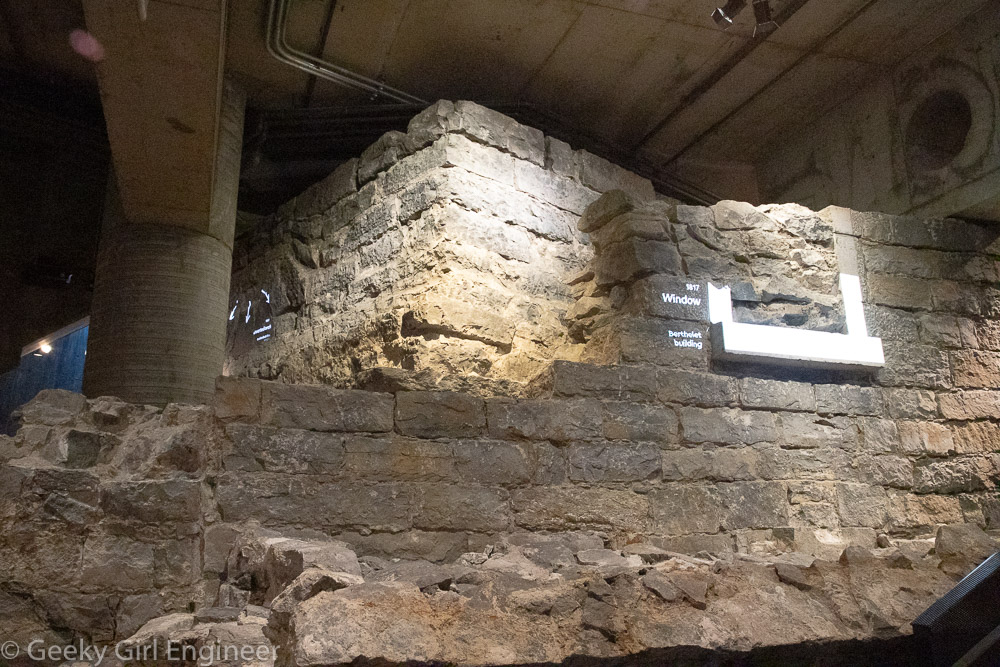
Foundation of the former Royal Insurance building and projection showing window of Berthelet building



